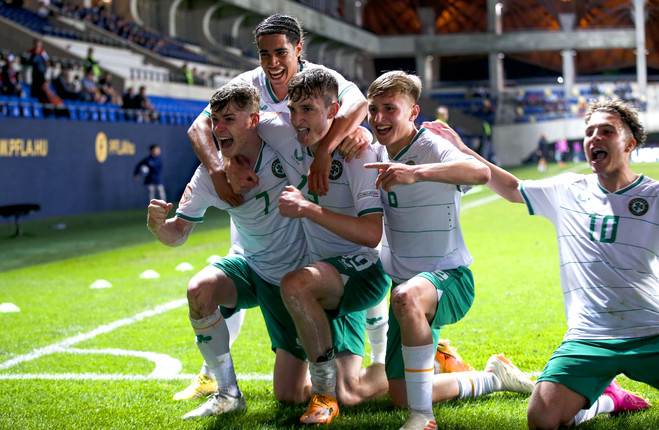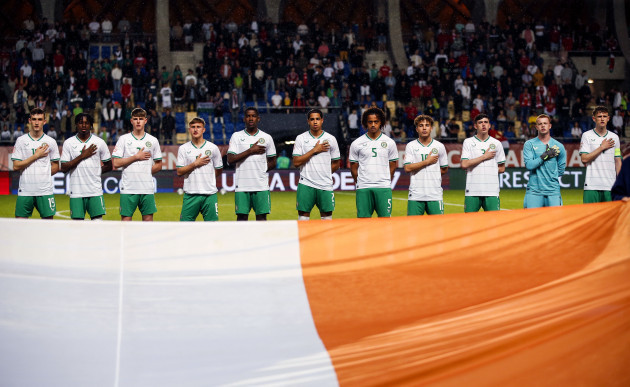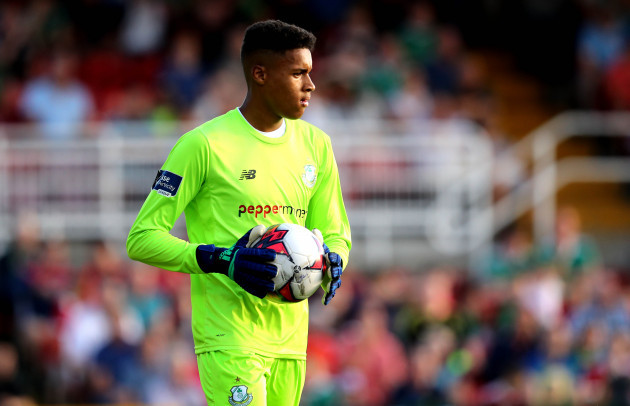THE SCALE OF the task facing the Irish U17s tonight is huge, but it is dwarfed by the very achievement of facing it.
Ireland face Spain tonight [KO: 7pm; Live on RTE News Channel and Player] in the quarter-finals of the U17 European Championships in Hungary with more than just a semi-final spot on offer. Win, and Ireland will qualify for the U17 World Cup for the very first time.
(Deep breath – there’s a complex backdoor to the World Cup if Ireland lose against Spain. If the four group winners of the Euros tournament so far – Spain, Poland, Germany, and England – win their quarter-finals, Ireland will have a World Cup play-off against Switzerland. If Switzerland win their quarter-final against Germany, then Ireland would have a play-off against Germany. No other combination of results would be enough for Ireland if they lose to Spain.)
Spain are characteristically daunting opponents, and their 15-year-old attacker Lamine Yamal has already signed up to Jorge Mendes’ agency and last month became the youngest player to make an appearance for Barcelona’s first team in more than a century.
“It will be a very tough challenge, Spain are an incredibly strong nation in youth football”, says Ireland boss Colin O’Brien. “Technically their players are so efficient, they are stacked with players from Barcelona and Atletico Madrid. But what an exciting game for us to be involved in.
“We are playing against a nation who like to dominate the ball and are masters are it from a very, very young age. We will have to be very patient, we will have to show a lot of intelligence, but we do have a threat.”
The main threat is St Patrick’s Athletic striker Mason Melia who, like Yamal, has played first-team football at 15, although his debut scene was more Camac than Catalonia. Other Irish players to have caught the eye in the group phase have been Melia’s clubmate Luke Kehir, Waterford’s Romeo Akachukwu, and Shamrock Rovers duo Naj Razi and Ike Orazi.
Ireland’s qualification from the group is impressive in the context of the tournament alone, given they opened with a chastening, 5-1 loss to Poland. But wins over Wales (3-0) and hosts Hungary (4-2) earned Ireland a knockout spot as group runners-up, ultimately missing out on top spot on goal difference after Wales beat Poland on the final day.
“There is that saying”, says O’Brien, “the consistency of inconsistency will come with young players. That is something you have to be aware of as a coach. We were very determined that we would not let [the Poland defeat] define us. It was just one game and when the stakes were at their highest, by God did they produce.”
Ireland’s is the youngest squad at the tournament by a distance, so to bounce back is truly creditable and their qualification becomes more remarkable the further you zoom out.
This is a post-Brexit Irish squad, meaning 18 of the 20-player squad are based at home and playing in the national underage leagues. This brings its benefits but it also complicates qualification, as the second (elite) phase took place before the Irish-based players begin their summer season, but during the winter season of so many of their opponents.
Internally, participating in the elite phase of qualifying was viewed as the realistic target for the campaign, but Ireland then topped a difficult group ahead of Italy, Ukraine, and Cyprus to qualify for the finals. The improbabilities have continued to stack up from there.
And then zoom further out again.
A recent Uefa report assessed European nations’ investment into youth development and provides neat contrast with the other seven quarter-finalists in the competition.
Germany, Poland, and Spain all average between 11 and 15 full-time academy coaches per top-division club.
France and Switzerland each average between eight and 10 full-time academy coaches per club.
England’s Premier League clubs didn’t return data but be sure theirs is a big number. (There are 15 Category One academies in the Premier League, and all are mandated to have a minimum of eight full-time coaches each.)
Serbia, meanwhile, have an average of between five and seven full-time academy coaches per top-tier club, which is the average across all of Europe.
Ireland’s equivalent for each Premier Division? It’s between zero and one.
Andorra, Northern Ireland and Luxembourg are the only countries to score as badly as Ireland on that front.
But yet, somehow, here we are.
Ireland has natural benefits in creating talented footballers: the participation rate of the game is the obvious one, and more esoteric is the multi-sport culture in which our young athletes grow. That playing many different sports is of huge benefit is becoming the consensus in the world of youth development, to the point that Benfica are seeking to create a multi-sport environment in their famed academy.
But bridging the coaching gap at elite academy level in Ireland will take considerable investment.
The FAI are seeking that investment now, and it was notable that they hosted a delegation from the Oireachtas Sport Committee at Abbottstown earlier this week. Their lobbying for a cut of the betting tax is part of this plan, as is the incipient production of an infrastructure plan and, later down the line, a player pathway strategy, for which a series of nationwide consultations are ongoing.
State investment is badly needed and long overdue. The Uefa report states that the amount of money the State puts into youth development at the 10 Premier Division clubs total a round €0.
The FAI are exploring other revenue streams as well, and the Fifa Talent Development Scheme that is overseen by Arsene Wenger may yet provide some funding as well.
But as necessary as State investment is, youth development across Europe is also the story of the rising tide of clubs’ private investment lifting national teams. 50% of investment in youth development at top-flight clubs across Western Europe came directly from the club involved.
Shamrock Rovers have been to the forefront of this in Ireland and they have the biggest representation in this U17s squad, with five players.
Rovers’ development of their academy at Roadstone was helped by investment from Ray Wilson and then Dermot Desmond, and while it initially made a loss - €354,000 in its first year, which grew to €410,000 two years later – it is now proving a worthwhile investment. Rovers made a profit of €409,753 as a club in 2021, with a note in the set of accounts saying the academy was beginning to bear fruit.
The sale of Gavin Bazunu to Manchester City for an initial €500,000 has proved lucrative and an example as to why other European clubs have invested so much in youth development. When negotiated add-ons and a sell-on clause are tallied, Rovers’ total earnings from that sale have reached a reported €3 million.
One of the FAI’s strategic aims is to increase their reach in schools, and Rovers have made their own move in this regard, partnering with Ashfield College to offer education around full-time academy football to students in Transition, fifth, and sixth year. Corey O’Sullivan, one of the Rovers’ quintet in the Irish U17s squad, graduated from the TY programme last year.
Given Bazunu was determined to complete his Leaving Cert, the link-up with Ashfield allowed Rovers to sign him to a professional contract, which in turn allowed them to negotiate a sale price to Man City. Had Bazunu not signed professional terms, Rovers would have lost him for a nominal compensation fee.
Rovers’ burgeoning success testifies to the benefits of significant academy investment, but also to its initial upfront costs. But as Uefa’s figures suggest, most of Europe made that investment years ago.
This U17s squad should be celebrated for their achievement regardless of the result against Spain, but nor should this distract from the more important issue.
First, applaud the squad that has succeeded against the odds.
And then work to ensure future sides are not hamstrung by such deep disadvantages.
Ireland U17 Squad vs Spain
Goalkeepers: Joe Collins (Bohemians), Jason Healy (Waterford)
Defenders: Stanley Ashbee (Hull City), Daniel Babb (UCD), Jake Grante (Crystal Palace), Kaylem Harnett (Wexford FC), Cory O’Sullivan (Shamrock Rovers), Ade Solanke (Shamrock Rovers)
Midfielders: Romeo Akachukwu (Waterford), Rhys Bartley (St. Patrick’s Athletic), Luke Kehir (St. Patrick’s Athletic), Matthew Moore (Cork City), Danny McGrath (Bohemians), Taylor Mooney (Bohemians), Freddie Turley (Shamrock Rovers)
Forwards: Mason Melia (St. Patrick’s Athletic), Matthew Murray (Cork City), Ike Orazi (Shamrock Rovers), Nickson Oksoun (Bohemians), Naj Razi (Shamrock Rovers)



